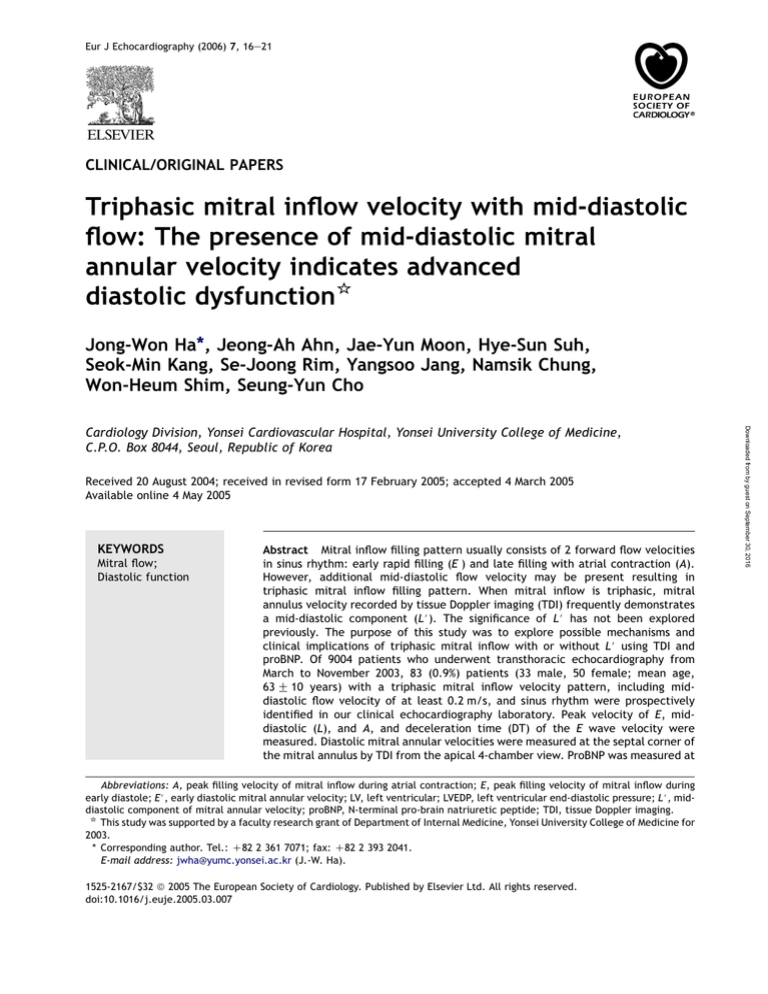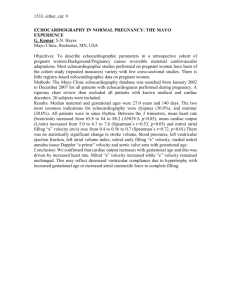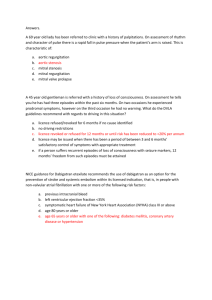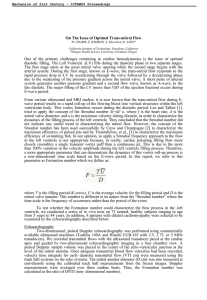
Eur J Echocardiography (2006) 7, 16e21
CLINICAL/ORIGINAL PAPERS
Triphasic mitral inflow velocity with mid-diastolic
flow: The presence of mid-diastolic mitral
annular velocity indicates advanced
diastolic dysfunction*
Jong-Won Ha*, Jeong-Ah Ahn, Jae-Yun Moon, Hye-Sun Suh,
Seok-Min Kang, Se-Joong Rim, Yangsoo Jang, Namsik Chung,
Won-Heum Shim, Seung-Yun Cho
Received 20 August 2004; received in revised form 17 February 2005; accepted 4 March 2005
Available online 4 May 2005
KEYWORDS
Mitral flow;
Diastolic function
Abstract Mitral inflow filling pattern usually consists of 2 forward flow velocities
in sinus rhythm: early rapid filling (E ) and late filling with atrial contraction (A).
However, additional mid-diastolic flow velocity may be present resulting in
triphasic mitral inflow filling pattern. When mitral inflow is triphasic, mitral
annulus velocity recorded by tissue Doppler imaging (TDI) frequently demonstrates
a mid-diastolic component (L#). The significance of L# has not been explored
previously. The purpose of this study was to explore possible mechanisms and
clinical implications of triphasic mitral inflow with or without L# using TDI and
proBNP. Of 9004 patients who underwent transthoracic echocardiography from
March to November 2003, 83 (0.9%) patients (33 male, 50 female; mean age,
63 G 10 years) with a triphasic mitral inflow velocity pattern, including middiastolic flow velocity of at least 0.2 m/s, and sinus rhythm were prospectively
identified in our clinical echocardiography laboratory. Peak velocity of E, middiastolic (L), and A, and deceleration time (DT) of the E wave velocity were
measured. Diastolic mitral annular velocities were measured at the septal corner of
the mitral annulus by TDI from the apical 4-chamber view. ProBNP was measured at
Abbreviations: A, peak filling velocity of mitral inflow during atrial contraction; E, peak filling velocity of mitral inflow during
early diastole; E#, early diastolic mitral annular velocity; LV, left ventricular; LVEDP, left ventricular end-diastolic pressure; L#, middiastolic component of mitral annular velocity; proBNP, N-terminal pro-brain natriuretic peptide; TDI, tissue Doppler imaging.
*
This study was supported by a faculty research grant of Department of Internal Medicine, Yonsei University College of Medicine for
2003.
* Corresponding author. Tel.: C82 2 361 7071; fax: C82 2 393 2041.
E-mail address: jwha@yumc.yonsei.ac.kr (J.-W. Ha).
1525-2167/$32 ª 2005 The European Society of Cardiology. Published by Elsevier Ltd. All rights reserved.
doi:10.1016/j.euje.2005.03.007
Downloaded from by guest on September 30, 2016
Cardiology Division, Yonsei Cardiovascular Hospital, Yonsei University College of Medicine,
C.P.O. Box 8044, Seoul, Republic of Korea
Triphasic mitral inflow
17
the time of echocardiogram using a quantitative electrochemiluminescence
immunoassay. Mean heart rate was 54 G 6 beats/min (range, 40e67). Mean left
ventricular (LV) ejection fraction (EF) was 64 G 13% and LV systolic dysfunction
(EF ! 40%) was present in only 6 (7%). Patients were classified into 2 groups: group
1 (n Z 47) included those who had L# and group 2 (n Z 36) included those without
L#. Group 1 patients had significantly higher peak velocity (35 G 14 vs 26 G 6 cm/s,
p Z 0.0002) and TVI (35 G 14 vs 26 G 6 cm/s, p Z 0.0002) of L, E/E# (18 G 8 vs
14 G 6, p Z 0.02), and left atrial volume index (42 G 14 vs 34 G 10 ml/m2,
p Z 0.0037). E# (4.7 G 1.3 vs 6.2 G 2.3 cm/s, p Z 0.001) and A# (6.2 G 2.0 vs
8.6 G 3.4 cm/s, p Z 0.0006) were significantly lower in group 1 compared with
those of group 2. ProBNP was significantly higher in group 1 (847 G 1461 vs
438 G 1039 pmol/l, p Z 0.0012) and it was above normal in all except in 1 patient
of group 1. In conclusion, the presence of L# in subjects with triphasic mitral inflow
velocity pattern with mid-diastolic flow is associated with higher E/E#, elevated
proBNP and enlarged left atrium indicating advanced diastolic dysfunction with
elevated filling pressures. This unique mitral annular velocity pattern should be
helpful in identifying the patients with advanced diastolic dysfunction and
increased LV filling pressures.
ª 2005 The European Society of Cardiology. Published by Elsevier Ltd. All rights
reserved.
Introduction
Methods
Study population
Of 9004 patients who underwent transthoracic
echocardiography from March to November 2003,
83 (0.9%) patients (33 male, 50 female; mean age,
63 G 10 years) with a triphasic mitral inflow velocity
pattern, including mid-diastolic flow velocity of at
least 0.2 m/s, and sinus rhythm were prospectively
identified in our clinical echocardiography laboratory. Patients were classified into 2 groups: group 1
(n Z 47) included those who had L# and group 2
(n Z 36) included those without L#. Comprehensive
echocardiographic evaluation of systolic and diastolic functions was performed. Clinical data were
obtained from clinical notes. This study was
approved by Institutional Review Board.
Two-dimensional and Doppler
echocardiography
Two-dimensional and Doppler echocardiography
was performed with a commercially available
echocardiographic unit equipped with an imaging
transducer having both pulsed wave and tissue
Doppler capability. The ejection fraction (EF) was
calculated with 2-dimensional echocardiography,
Downloaded from by guest on September 30, 2016
Diastole consists of 3 phases: early rapid filling,
diastasis, and atrial contraction. Because diastasis
is the quiescent phase characterized by an overall
balance of forces and an absence of an atrioventricular pressure gradient, mitral inflow velocities
obtained by pulsed wave Doppler echocardiography usually consist of 2 forward flow velocity peaks
in sinus rhythm: early diastolic peak from early
rapid filling (E) and late filling peak from atrial
contraction (A). However, mitral inflow may have
additional forward flow velocity during mid-diastole.1,2 The prominent mid-diastolic filling wave,
which has been described as an L wave,1 is rarely
encountered and the mechanism and its clinical
implications are still elusive.
Tissue Doppler imaging (TDI) is a recent Doppler
application that allows direct measurement of
myocardial velocities. Previous studies suggested
that early diastolic mitral annular velocity (E#)
recorded by TDI is a simple and reliable noninvasive index of left ventricular (LV) relaxation3e6
with a significant inverse correlation between E#
and t.4,5 It is also useful in estimating LV filling
pressure.6,7 When mitral inflow is triphasic, mitral
annulus velocity recorded by TDI frequently demonstrates a mid-diastolic component (L#). However, the significance of L# has not been explored
previously. Recently, N-terminal pro-brain natriuretic peptide (proBNP), a peptide hormone secreted from the cardiac ventricles in response to
increased pressure and volumes, has been shown
as a good predictor of high LV end-diastolic
pressure (LVEDP) in patients with LV systolic
dysfunction.8 However, no data are available
regarding TDI and proBNP in patients with triphasic
mitral inflow with mid-diastolic flow. The purpose
of this study was to explore possible mechanisms
and clinical implications of triphasic mitral inflow
with or without L# using TDI and proBNP.
18
with a modification of the method of Quinones
et al.9 Left atrial volume was measured with the
modified biplane area-length method.10,11 From
the apical window, the pulsed Doppler sample
volume was placed at the mitral valve tips, and
5e10 cardiac cycles were recorded. From the
mitral inflow velocities, the following variables
were measured: peak velocity and time velocity
integral of early (E), mid-diastolic (L), and late (A)
filling, and deceleration time (DT) of the E wave
velocity. TDI was used to measure mitral annular
velocities, E#, A#, and L# (Fig. 1). For TDI, the filter
setting was lowered, and the Nyquist limit was
adjusted (range, 15e20 cm/s). Gain was minimized to allow for a clear tissue signal with
minimal background noise. From the apical 4chamber view, a 2- to 3-mm sample volume of
TDI was placed at the septal corner of the mitral
annulus. Measurements were recorded with simultaneous electrocardiography at a sweep speed of
50e100 mm/s. Mitral inflow filling pattern was also
observed during Valsalva maneuver to evaluate the
effects of preload.
J.-W. Ha et al.
Before analysis, each tube was inverted several
times to ensure homogeneity. The whole blood was
then analyzed in triplicate by electrochemiluminescence immunoassay method for proBNP (Elecsys
proBNP, Roche Diagnostics, Basel, Switzerland).
Results
Clinical characteristics
Measurement of NT proBNP
Echocardiography
Blood samples for proBNP analysis were drawn
immediately after echocardiographic study, and
kept at 4 C and analyzed within 4 h of sampling.
LV end-diastolic and end-systolic dimensions and
EF were 51 G 7 mm, 34 G 8 mm, and 64 G 13%,
Figure 1 Mitral inflow and annulus velocity pattern in a patient with triphasic mitral inflow with prominent middiastolic filling (L). E, peak velocity of mitral inflow early filling; E#, early diastolic mitral annular velocity; A, peak
velocity of mitral inflow late filling during atrial contraction; A#, late diastolic mitral annular velocity; L#, middiastolic mitral annular velocity.
Downloaded from by guest on September 30, 2016
The mean heart rate of 33 men and 50 women
(mean age, 63 G 10 years) at the time of the
echocardiogram was 54 G 6 beat/min (range, 40e
67). Systolic and diastolic blood pressures at the
time of the examination were 139 G 22 and
80 G 14 mmHg, respectively. However, a history
of hypertension was present in 52 (63%) of 83
patients. Most common associated conditions were
coronary artery disease (n Z 23), hypertrophic
cardiomyopathy (n Z 16), and end-stage renal
failure (n Z 10). Of 83 patients, 14 patients (17%)
presented as a congestive heart failure. Two
patients had paroxysmal atrial fibrillation.
Triphasic mitral inflow
19
Table 1 Comparison of clinical variables between
patients with or without mid-diastolic mitral annular
velocity (L#)
Age (years)
Gender (M/F)
BSA (m2)
Hypertension
Diabetes mellitus
Systolic BP
(mmHg)
Diastolic BP
(mmHg)
HR (beat/min)
Group 1
(n Z 47)
Group 2
(n Z 36)
p Value
62 G 11
15/32
1.61 G 0.16
26 (62%)
10 (24%)
140 G 23
65 G 9
18/18
1.66 G 0.17
26 (72%)
11 (31%)
139 G 20
0.12
0.1
0.19
0.38
0.56
0.81
81 G 12
79 G 17
0.58
54 G 6
52 G 6
0.11
M, male; F, female; BSA, body surface area; BP, blood
pressure; HR, heart rate.
Table 2 Echocardiographic variables between patients with or without mid-diastolic mitral annular
velocity (L#)
LVEDD (mm)
LVESD (mm)
LV EF(%)
IVS (mm)
PW (mm)
LVMI (g/m2)
LAV (ml)
LAVI (ml/m2)
Group 1
(n Z 47)
Group 2
(n Z 36)
p Value
50 G 6
34 G 8
63 G 15
12 G 4
10 G 2
136 G 44
68 G 23
42 G 14
52 G 7
34 G 8
64 G 10
11 G 2
10 G 2
129 G 40
55 G 18
34 G 10
0.31
0.81
0.67
0.09
0.77
0.45
0.01
0.0037
LVEDD, left ventricular end-diastolic dimension; LVESD, left
ventricular end-systolic dimension; EF, ejection fraction;
IVS, interventricular septum; PW, posterior wall; LVMI, left
ventricular mass index; LAV, left atrial volume; LAVI, left
atrial volume index.
patients were from group 2. Valsalva maneuver
performed in 81 patients unmasked a delayed
relaxation pattern in 69 (85%).
Plasma level of proBNP
ProBNP was normal, defined as %20 pmol/l, in only
7 (7%) of 83 patients and it was significantly higher
in group 1 (847 G 1461 vs 438 G 1039 pmol/l,
p Z 0.0012) when compared with that of group 2.
All except 1 patient of group 1 had elevated
proBNP.
Table 3 Mitral inflow and annular velocities and
proBNP between patients with or without mid-diastolic mitral annular velocity (L#)
E (m/s)
A (m/s)
E/A
DT (ms)
L (m/s)
TVI of L
E# (cm/s)
A# (cm/s)
E/E#
ProBNP
(pmol/l)
Group 1
(n Z 47)
Group 2
(n Z 36)
p Value
0.77 G 0.22
0.60 G 0.26
1.5 G 0.6
192 G 46
0.35 G 0.14
6.2 G 3.2
4.7 G 1.3
6.2 G 2.0
18 G 8
847 G 1461
0.79 G 0.20
0.65 G 0.18
1.3 G 0.5
192 G 45
0.26 G 0.06
4.6 G 1.1
6.2 G 2.3
8.6 G 3.4
14 G 6
438 G 1039
0.68
0.35
0.22
0.97
0.0002
0.0079
0.001
0.0006
0.02
0.0012
E, mitral early diastolic filling velocity; A, mitral late
diastolic filling velocity; DT, deceleration time of E wave;
L, mitral mid-diastolic filling velocity; TVI, time velocity
integral; E 0 , early diastolic mitral annular velocity; A0 , mitral
annular velocity during atrial contraction.
Downloaded from by guest on September 30, 2016
respectively. The thickness of the ventricular
septum and the posterior wall was 11 G 3 and
10 G 2 mm, respectively. Mean LV mass was
216 G 73 g. LV hypertrophy, defined as an LV mass
index of more than 116 g/m2 in men and more than
104 g/m2 in women,12 was noted in 54 patients
(65%). Mean left atrial volume index was
39 G 13 ml/m2. Left atrial volume index was above
normal, greater than 23 ml/m2 in 75 (90%) of 83
patients. LV systolic dysfunction, an EF of less than
40%, was present in 6 (7%) of 83 patients. Patients
were classified into 2 groups: group 1 (n Z 47)
included those who had L# and group 2 (n Z 36)
included those without L#. There were no significant differences in age, gender, heart rate,
systolic and diastolic blood pressures, LV enddiastolic, end-systolic dimensions, EF and LV mass
index. Left atrial volume and left atrial volume
index of group 1 were significantly larger than
those of patients of group 2 (left atrial volume,
68 G 23 vs 55 G 18 ml, p Z 0.01; left atrial volume
index, 42 G 14 vs 34 G 10 ml, p Z 0.0037) (Tables
1 and 2). Group 1 patients had significantly higher
peak velocity (35 G 14 vs 26 G 6 cm/s, p Z 0.0002)
and TVI (6.2 G 3.2 vs 4.6 G 1.1 cm, p Z 0.0079) of
L. E# (4.7 G 1.3 vs 6.2 G 2.3 cm/s, p Z 0.001) and
A# (6.2 G 2.0 vs 8.6 G 3.4 cm/s, p Z 0.0006) were
significantly lower in group 1 compared with that
of group 2. E/E# was significantly higher in patients
of group 1 compared with that of group 2 (18 G 8
vs 14 G 6, p Z 0.02) (Table 3). Normal filling
pressure, estimated as an E/E# ratio less than 8,
was observed in only 3 (3.6%) patients but none of
the patients from group 1. E/E# ratio more than 15
was observed in 30 (64%) of 47 patients of group 1
and 13 (36%) of 36 patients of group 2. E# was less
than 0.1 m/s in all except in 2 patients and these
20
Discussion
Associated clinical conditions
Most of the patients with triphasic mitral inflow
velocity pattern have underlying cardiovascular
diseases, such as hypertension, hypertrophic cardiomyopathy, or ischemic heart disease suggesting
that triphasic flow is not a normal phenomenon.
Based on surrogate markers, most patients with
triphasic mitral inflow appeared to have elevated
filling pressures.
Effect of myocardial relaxation
Early diastolic mitral annular velocity recorded by
TDI has been correlated with t5 and is thought to
reflect myocardial relaxation. Mitral annulus velocity was shown to be relatively preload independent, especially in patients with impaired
relaxation.14 Therefore, early diastolic mitral annular velocity, a noninvasive surrogate of myocardial relaxation, is well suited for assessing the
underlying mechanism of triphasic mitral inflow
with mid-diastolic filling. When myocardial relaxation is normal, E# is usually 0.1 m/s or greater. In
this study, E# was less than 0.1 m/s in all except in
2 patients, which suggests impaired myocardial
relaxation in patients with a triphasic mitral inflow
pattern. This finding was further confirmed by the
Valsalva maneuver, which unmasked a delayed
relaxation pattern in most of these patients.
Effect of preload
ProBNP, a peptide hormone secreted from the
cardiac ventricles in response to increased pressure and volumes, has been shown as a good
predictor of high LVEDP in patients with LV systolic
dysfunction.8 In this study, more than 90% of
patients had above normal range of proBNP level.
In addition, it is significantly higher in patients
with L#, suggesting LV filling pressures are elevated
in these patients. The results of the Valsalva
maneuver which unmasked delayed relaxation
pattern in 85% of the patients also indicate that
elevated filling pressure contributes to the triphasic mitral inflow pattern. Increased E/E# also substantiated the importance of increased preload in
producing the triphasic mitral inflow pattern in
these patients.
Underlying mechanism of L# is not clear. Frommelt et al. have shown that prolonged LV pressure
decrease into mid-diastole was preceded by middiastolic mitral annular motion toward the ventricle.15 Thus, mid-diastolic mitral annular motion,
a delayed wave of active relaxation, may create
a diastolic suction effect in mid-diastole and leads
to mid-diastolic inflow across the mitral valve.
Study limitations
In this study, we do not have invasive hemodynamic correlation of our findings. However, previous investigations have shown that an E/E# ratio
of more than 15 identified increased LV filling
pressure.6,7 In addition, elevated proBNP in the
presence of normal systolic function is specific for
the prediction of elevated LV end-diastolic and
filling pressures.16 In this study, we do not have
controls.
We conclude that the presence of L# in subjects
with triphasic mitral inflow velocity pattern with
mid-diastolic flow is associated with higher E/E#,
elevated proBNP and enlarged left atrium suggesting advanced diastolic dysfunction with elevated
filling pressures. This unique mitral annular velocity
Downloaded from by guest on September 30, 2016
Although the presence of L# is relatively uncommon, the novel finding of this study is that the
presence of L# in subjects with triphasic mitral
inflow velocity pattern with mid-diastolic flow is
associated with higher E/E#, elevated proBNP and
enlarged left atrium indicating advanced diastolic
dysfunction with elevated filling pressures. To the
best of our knowledge, this study is the largest and
first study which provided proBNP level and the
importance of mid-diastolic mitral annulus velocity in patients with triphasic mitral flow.
Previous studies on the mechanism of triphasic
mitral inflow with mid-diastolic filling produced
conflicting results. Keren et al.,1 who studied 12
healthy volunteers using M-mode and Doppler
echocardiography, concluded that mid-diastolic
flow arises from the reestablishment of a positive
transmitral pressure gradient due to left atrial
filling from the pulmonary veins. Smiseth and
Thompson13 also suggested that mid-diastolic filling is driven by the momentum of the blood that
enters the atrium from the pulmonary veins,
because of the small transmitral pressure gradient
during diastasis. In contrast, Hatle2 described
a mid-diastolic increase in forward mitral flow
velocity in a patient with marked LV hypertrophy
and suggested that a prominent mid-diastolic flow
was the result of markedly prolonged relaxation
that lowers LV diastolic pressure during mid-diastole. However, few data are available regarding
TDI and proBNP.
J.-W. Ha et al.
Triphasic mitral inflow
pattern should be helpful in identifying the patients
with advanced diastolic dysfunction and increased
LV filling pressures and complimentary to the other
measures of diastolic function.
References
8. Maeda K, Tsutamoto T, Wada A, Hisanaga T, Kinoshita M.
Plasma brain natriuretic peptide as a biochemical marker of
high left ventricular end-diastolic pressure in patients with
symptomatic left ventricular dysfunction. Am Heart J 1998;
135:825e32.
9. Quinones MA, Waggoner AD, Reduto LA, et al. A new,
simplified and accurate method for determining ejection
fraction with two-dimensional echocardiography. Circulation 1981;64:744e53.
10. Ren JF, Kotler MN, DePace NL, et al. Two-dimensional
echocardiographic determination of left atrial emptying
volume: a noninvasive index in quantifying the degree of
nonrheumatic mitral regurgitation. J Am Coll Cardiol 1983;
2:729e36.
11. Appleton CP, Galloway JM, Gonzalez MS, Gaballa M,
Basnight MA. Estimation of left ventricular filling pressures
using two-dimensional and Doppler echocardiography in
adult patients with cardiac disease: additional value of
analyzing left atrial size, left atrial ejection fraction and
the difference in duration of pulmonary venous and mitral
flow velocity at atrial contraction. J Am Coll Cardiol 1993;
22:1972e82.
12. Devereux RB, Dahlof B, Levy D, Pfeffer MA. Comparison of
enalapril versus nifedipine to decrease left ventricular
hypertrophy in systemic hypertension (the PRESERVE trial).
Am J Cardiol 1996;78:61e5.
13. Smiseth OA, Thomson CR. Atrioventricular filling dynamics,
diastolic function and dysfunction. Heart Fail Rev 2000;5:
291e9.
14. Nagueh SF, Sun H, Kopelen HA, Middleton KJ, Khoury DS.
Hemodynamic determinants of the mitral annulus diastolic
velocities by tissue Doppler. J Am Coll Cardiol 2001;37:
278e85.
15. Frommelt PC, Pelech AN, Frommelt MA. Diastolic dysfunction in an unusual case of cardiomyopathy in a child:
insights from Doppler and Doppler tissue imaging analysis.
J Am Soc Echocardiogr 2003;16:176e81.
16. Joung B, Ha JW, Ko YG, Kang SM, Rim SJ, Jang Y, et al. Can
proBNP be used as a noninvasive predictor of elevated left
ventricular diastolic pressures in patients with normal
systolic function? Am Heart J, in press.
Downloaded from by guest on September 30, 2016
1. Keren G, Meisner JS, Sherez J, Yellin EL, Laniado S.
Interrelationship of mid-diastolic mitral valve motion,
pulmonary venous flow, and transmitral flow. Circulation
1986;74:36e44.
2. Hatle L. Doppler echocardiographic evaluation of diastolic
function in hypertensive cardiomyopathies. Eur Heart J
1993;14(Suppl. J):88e94.
3. Rodriguez L, Garcia MJ, Ares M, Griffin BP, Nakatani S,
Thomas JD. Assessment of mitral annular dynamics during
diastole by Doppler tissue imaging: comparison with mitral
Doppler inflow in subjects without heart disease and in
patients with left ventricular hypertrophy. Am Heart J
1996;131:982e7.
4. Oki T, Tabata T, Yamada H, et al. Clinical application of
pulsed Doppler tissue imaging for assessing abnormal left
ventricular relaxation. Am J Cardiol 1997;79:921e8.
5. Sohn DW, Chai IH, Lee DJ, et al. Assessment of mitral
annulus velocity by Doppler tissue imaging in the evaluation
of left ventricular diastolic function. J Am Coll Cardiol
1997;30:474e80.
6. Nagueh SF, Middleton KJ, Kopelen HA, Zoghbi WA,
Quinones MA. Doppler tissue imaging: a noninvasive technique for evaluation of left ventricular relaxation and
estimation of filling pressures. J Am Coll Cardiol 1997;30:
1527e33.
7. Ommen SR, Nishimura RA, Appleton CP, Miller FA, Oh JK,
Redfield MM, et al. Clinical utility of Doppler echocardiography and tissue Doppler imaging in the estimation of
left ventricular filling pressures: a comparative simultaneous Doppler-catheterization study. Circulation 2000;
102:1788e94.
21




